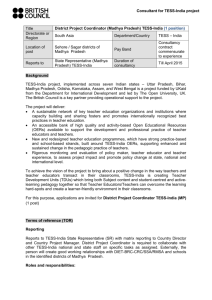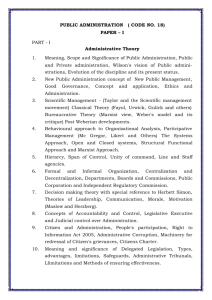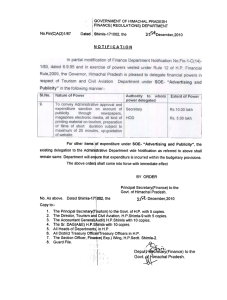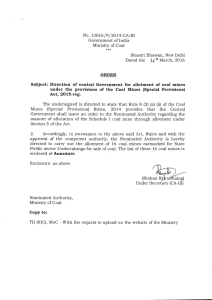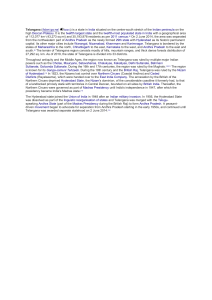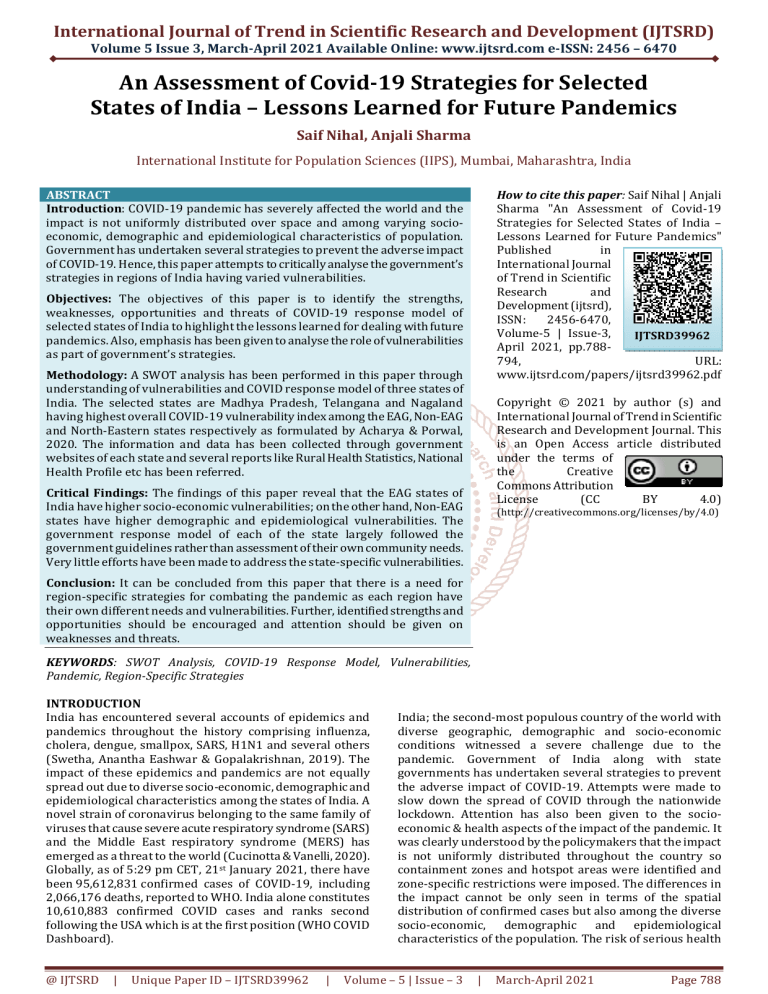
International Journal of Trend in Scientific Research and Development (IJTSRD)
Volume 5 Issue 3, March-April 2021 Available Online: www.ijtsrd.com e-ISSN: 2456 – 6470
An Assessment of Covid-19 Strategies for Selected
States of India – Lessons Learned for Future Pandemics
Saif Nihal, Anjali Sharma
International Institute for Population Sciences (IIPS), Mumbai, Maharashtra, India
ABSTRACT
Introduction: COVID-19 pandemic has severely affected the world and the
impact is not uniformly distributed over space and among varying socioeconomic, demographic and epidemiological characteristics of population.
Government has undertaken several strategies to prevent the adverse impact
of COVID-19. Hence, this paper attempts to critically analyse the government’s
strategies in regions of India having varied vulnerabilities.
How to cite this paper: Saif Nihal | Anjali
Sharma "An Assessment of Covid-19
Strategies for Selected States of India –
Lessons Learned for Future Pandemics"
Published
in
International Journal
of Trend in Scientific
Research
and
Development (ijtsrd),
ISSN:
2456-6470,
Volume-5 | Issue-3,
IJTSRD39962
April 2021, pp.788794,
URL:
www.ijtsrd.com/papers/ijtsrd39962.pdf
Objectives: The objectives of this paper is to identify the strengths,
weaknesses, opportunities and threats of COVID-19 response model of
selected states of India to highlight the lessons learned for dealing with future
pandemics. Also, emphasis has been given to analyse the role of vulnerabilities
as part of government’s strategies.
Methodology: A SWOT analysis has been performed in this paper through
understanding of vulnerabilities and COVID response model of three states of
India. The selected states are Madhya Pradesh, Telangana and Nagaland
having highest overall COVID-19 vulnerability index among the EAG, Non-EAG
and North-Eastern states respectively as formulated by Acharya & Porwal,
2020. The information and data has been collected through government
websites of each state and several reports like Rural Health Statistics, National
Health Profile etc has been referred.
Copyright © 2021 by author (s) and
International Journal of Trend in Scientific
Research and Development Journal. This
is an Open Access article distributed
under the terms of
the
Creative
Commons Attribution
License
(CC
BY
4.0)
Critical Findings: The findings of this paper reveal that the EAG states of
India have higher socio-economic vulnerabilities; on the other hand, Non-EAG
states have higher demographic and epidemiological vulnerabilities. The
government response model of each of the state largely followed the
government guidelines rather than assessment of their own community needs.
Very little efforts have been made to address the state-specific vulnerabilities.
(http://creativecommons.org/licenses/by/4.0)
Conclusion: It can be concluded from this paper that there is a need for
region-specific strategies for combating the pandemic as each region have
their own different needs and vulnerabilities. Further, identified strengths and
opportunities should be encouraged and attention should be given on
weaknesses and threats.
KEYWORDS: SWOT Analysis, COVID-19 Response Model, Vulnerabilities,
Pandemic, Region-Specific Strategies
INTRODUCTION
India has encountered several accounts of epidemics and
pandemics throughout the history comprising influenza,
cholera, dengue, smallpox, SARS, H1N1 and several others
(Swetha, Anantha Eashwar & Gopalakrishnan, 2019). The
impact of these epidemics and pandemics are not equally
spread out due to diverse socio-economic, demographic and
epidemiological characteristics among the states of India. A
novel strain of coronavirus belonging to the same family of
viruses that cause severe acute respiratory syndrome (SARS)
and the Middle East respiratory syndrome (MERS) has
emerged as a threat to the world (Cucinotta & Vanelli, 2020).
Globally, as of 5:29 pm CET, 21st January 2021, there have
been 95,612,831 confirmed cases of COVID-19, including
2,066,176 deaths, reported to WHO. India alone constitutes
10,610,883 confirmed COVID cases and ranks second
following the USA which is at the first position (WHO COVID
Dashboard).
@ IJTSRD
|
Unique Paper ID – IJTSRD39962
|
India; the second-most populous country of the world with
diverse geographic, demographic and socio-economic
conditions witnessed a severe challenge due to the
pandemic. Government of India along with state
governments has undertaken several strategies to prevent
the adverse impact of COVID-19. Attempts were made to
slow down the spread of COVID through the nationwide
lockdown. Attention has also been given to the socioeconomic & health aspects of the impact of the pandemic. It
was clearly understood by the policymakers that the impact
is not uniformly distributed throughout the country so
containment zones and hotspot areas were identified and
zone-specific restrictions were imposed. The differences in
the impact cannot be only seen in terms of the spatial
distribution of confirmed cases but also among the diverse
socio-economic, demographic and epidemiological
characteristics of the population. The risk of serious health
Volume – 5 | Issue – 3
|
March-April 2021
Page 788
International Journal of Trend in Scientific Research and Development (IJTSRD) @ www.ijtsrd.com eISSN: 2456-6470
complications as well as the risk of dying as a result of
COVID-19 grow rapidly with age and are much higher among
people with pre-existing health conditions such as
cardiovascular conditions, diabetes, hypertension, chronic
pulmonary disease and malignancy (Brandt et.al, 2020).
Also, the COVID-19 has disproportionally affected the poor,
minorities and a broad range of vulnerable populations, due
to its inequitable spread in areas of dense population and
limited mitigation capacity due to high prevalence of chronic
conditions or poor access to high-quality public health and
medical care (Shadmi et.al, 2020; Muscat & Kluge, 2020;
Burstrom & Tao, 2020). Further COVID-19 has highlighted
health inequities as along with the demographic and
socioeconomic variables, the availability and quality of
health care is significantly related to the variability in
COVID-19 prevalence, mortality and case fatality rates
(Phillip Rajkumar, 2020).
Literatures have identified that the pandemic is not
uniformly spread out and the vulnerability of COVID-19 is
higher among lower socioeconomic strata, older age group
and persons suffering from chronic diseases. From a policy
point of view, India has been divided into Empowered Action
Group states, Non-Empowered Action Group states and
North-Eastern states to address the varied socio-economic
and demographic conditions. The Empowered Action Group
(EAG) is socio-economically backward states in India which
are given special attention in development interventions.
These states also lag in demographic transition; on the other
hand, the rest of the states are at advanced stages of
demographic transition; many have achieved replacement
level of fertility. Besides, the non-EAG states have a high
literacy rate, high life expectancy and the share of the elderly
population is high (Kumar & Kumar, 2019).
As the need of the hour is to adopt suitable strategies to
address the vulnerability of socially deprived and
economically marginalized communities to protect
themselves (Singh et.al 2020), the pandemic related
strategies should focus on these various regions. The
rationale of this paper emerge from the argument that as
compared to the SARS outbreak, the international response
to COVID-19 has been more transparent and efficient so,
various key learning points need to be recorded from the
outbreak COVID-19 to combat any kind of outbreak in future
(Chaurasiya et.al, 2020). Hence, this paper attempts to study
the strategies of government based on different levels of
COVID-19 vulnerability in three regions of India namely EAG
states, Non-EAG states and North-Eastern states so that
necessary lessons can be learned for future pandemics.
Objectives
This paper aims to highlight the lessons learned from the
strategies of the government for better response to future
pandemics. Following are the objectives of the paper:
Critically analysing how well the COVID-19 response
model has emphasized socio-economic and healthrelated vulnerability in selected states of India
Identifying the strengths, weaknesses, opportunities and
threats for the state having the highest COVID
vulnerability in each of the region i.e. EAG, Non-EAG and
North-eastern.
Identifying lessons learned for strategy formulation of
future pandemics at the national level through the
SWOT Analysis.
@ IJTSRD
|
Unique Paper ID – IJTSRD39962
|
Data Source & Methodology
To fulfil the objectives of this paper, the information and
data have been collected from various secondary sources
like literatures, journals, newspaper articles, and
government websites of respective states. The data for state
profile has been taken from Rural Health Statistics 2019,
SRS-2018, Census, 2011 and National Health Profile Report
2019. Madhya Pradesh, Telangana and Nagaland are selected
as states of India for the study through two levels of
procedure. Firstly the whole country has been divided into
three regions namely, Empowered Action Group states, the
Non-Empowered Action Group States and Northern Eastern
states from the relevance of policymaking. Empowered
Action Group region is comprised of Bihar, Jharkhand,
Odisha, Chhattisgarh, Madhya Pradesh, Rajasthan, Uttar
Pradesh and Uttarakhand. North-Eastern states include
Assam, Arunachal Pradesh, Sikkim, Mizoram, Nagaland,
Manipur, Tripura and Meghalaya. The remaining states are
classified as Non-EAG states. At the second level, from each
region, one state is being selected as representative of each
region having the highest overall COVID vulnerability index
formulated by Acharya et.al. 2020. An attempt has been
made to understand how effectively each state has
addressed the socio-economic and health-related
vulnerabilities. Further SWOT analysis has been applied to
understand the strengths, weaknesses, opportunities and
threats of COVID-19 strategies of selected states of India.
Finally, a window of strengths and opportunities is being
developed and recommendation has been put forth for
future pandemics at the national level.
Result & Discussion
1. Madhya Pradesh: (EAG State)
Madhya Pradesh is a state in Central India and is one of the
Empowered Action Group States with a population density of
236 persons per sq. km. The population of Madhya Pradesh
is composed of 7.1% elderly population of age 60 & above.
According to SRS 2018, the total fertility rate is 2.7 children
per women, the infant mortality rate is 48 infant deaths per
1000 live births and maternal mortality ratio is 173
maternal deaths per lakh live births. The state of Madhya
Pradesh has performed poorly in terms of demographic
indicators. Madhya Pradesh has a large proportion of the
population below the poverty line with 31.6% in 2011-12
and the literacy rate is only 69.3%. This indicates that
Madhya Pradesh is way behind in socio-economic indicators.
The health expenditure as a percentage of state GSDP is
1.04%, the lowest among the EAG states of India. In terms of
health infrastructure, Madhya Pradesh has 0.9 sub-centres to
5000 rural population, 0.5 public health centres to 30000
rural population and 0.6 community health centres for
120000 rural populations in 2019 which is much lower than
the Indian Public Health Standards Norms. Also, there are
only 0.006 government hospitals per 1000 population and
0.377 government hospital beds per 1000 population, which
is much lower than the national average. It has 10 medical
colleges and 150 mobile medical units. In terms of human
resources in the health sector, Madhya Pradesh has 38180
registered doctors in 2018, 39563 registered ANM and
118793 registered nurses & midwives in 2016-17.
COVID-19 Scenario in Madhya Pradesh
As of 19th January 2021, Madhya Pradesh has 251882
confirmed cases of COVID-19. The recovery ratio for the
state is 96.1% which is lower than the national average and
all other EAG states except Uttarakhand. The case-fatality
Volume – 5 | Issue – 3
|
March-April 2021
Page 789
International Journal of Trend in Scientific Research and Development (IJTSRD) @ www.ijtsrd.com eISSN: 2456-6470
ratio is highest in Madhya Pradesh among all EAG states with
1.5% following Uttarakhand (1.7%). The case fatality ratio of
Madhya Pradesh is higher than the national average. The test
positivity ratio is 4.9% and Madhya Pradesh has conducted
62200 tests per 10 lakh population which is lowest among
all states of India excluding Nagaland.
COVID-19 Response Model of Madhya Pradesh:
The first confirmed case of COVID-19 was found on 20th
March 2020 in Bhopal, Madhya Pradesh through wellestablished testing and surveillance of international
passengers since 28th January 2020. A nationwide lockdown
was followed in the state as per national guidelines imposing
several restrictions on public gathering and movement.
Madhya Pradesh faced dramatic power tussle game during
the initial stage of pandemic. The first initiative of the
government of Madhya Pradesh for combating with COVID19 was based on Kerala model to tackle COVID-19 infection,
which was prepared by following WHO protocol of test trace
isolate and support to form and implement a strategy. It is
known as the IITT Approach which refers to identification,
isolation, testing and treatment. Several other targeted
measures and interventions involved a survey with Kill
Corona campaign for SARI/ILI, formulation of Rapid
Response Team (RRT) and Special Response Team (SRT) and
use of SARTHAK app for active surveillance. While the early
stage focused on the screening of international travellers, the
focus in February- march was on improving health capacity
and restricting social gathering. The helpline number was
introduced and availability of masks and PPE kits were
emphasised. Telemedicine unit was also established in 51
district hospitals. Further, financial assistance was given to
construction labourers, families of Sahariya, Baiga and
Bhraia tribes, Social security pensioners were paid advance
pensions and people without eligibility slips under National
Food Security Scheme was allowed to receive ration.
Necessary steps were also taken for migrants through
coordinating with other states.
COVID-19 Vulnerability and Government Strategies
Madhya Pradesh has the highest overall COVID vulnerability
among all states of India with value 1.0. Index for socioeconomic vulnerability, vulnerability due to availability of
health care and vulnerability due to housing & hygiene
condition is highest in Madhya Pradesh among all EAG states
with value 0.886, 0.857 and 0.971 respectively. The
demographic vulnerability is lower in Madhya Pradesh with
a value close to zero i.e. 0.20. The index of epidemiological
vulnerability is moderate with a value of 0.600.
According to the vulnerability index, there is serious concern
regarding the availability of health care, socio-economic
characteristics and housing and hygiene condition. There
have been several measures for tribal, migrants and poor
population in the COVID-19 strategies of government but
there is a lot more required looking at the vulnerabilities.
Also, efforts have been made through the introduction of a
telemedicine system to address the epidemiological
vulnerability. For the availability of health care, PPE Kits,
N95 masks and other medical types of equipment were
arranged. Fever clinics were activated across the state as a
potent modality for passive surveillance. Along with this
COVID, warriors came in many forms for tackling the
pandemic. Residential areas were divided into sectors, with
Accredited Social Health Activist (ASHA)/grassroots-level
health workers each covering a maximum of 100 households
(50 households in difficult areas).
@ IJTSRD
|
Unique Paper ID – IJTSRD39962
|
2. Telangana: Non-Empowered Action Group State
Telangana is a state in southern India, carved out from
Andhra Pradesh in 2014 with a population density of 312
persons per sq. km. It has 8.1% elderly population of 60 and
above ages which is equivalent to the national average. As
per SRS 2018, the total fertility rate in Telangana is 1.6
children per women, the infant mortality rate is 27 infant
deaths per 1000 live births and Maternal Mortality Ratio is
63 maternal deaths per 100000 live births. Telangana’s
health expenditure as a percentage of GSDP is only 0.82%
which is much lower than all north-eastern states and
empowered action group states in 2015-16 (NHP-2019).
Telangana has 4042 registered doctors in 2018, 2762
registered ANM and 9397 registered nurses and midwives in
2016-17. Telangana has no Public Health Centre and only 0.5
Community Health Centre per 120000 rural populations
which is much lower than the established norms of Indian
Public Health Standards (IPHS) in 2019. But it has 1.1:5000
for sub-centre which is as per the health institution norms.
There are .022 government hospitals per 1000 population
which lower than the national average, in contrast, the
number of government hospital beds per 1000 population is
1.02 which is higher than the national average in 2015-16.
There are 7 medical colleges in Telangana and no mobile
medical units in 2019.
COVID-19 Scenario in Telangana
As of 19th January 2021, Telangana has 291872 confirmed
cases of COVID-19. Among Non-EAG states, the recovery
ratio of Telangana is third highest with 98.1% following
Andhra Pradesh (99%) and Haryana (98.2%). The casefatality ratio is 0.5% with rank second among Non-EAG
states from the lower bottom following Kerala with 0.4%.
The test positivity ratio is 3.9% which is lower than the
national average of 5.6%. Telangana has conducted 200000
tests for per 10 lakh population.
COVID-19 Response Model of Telangana:
The first case of COVID was reported on 2nd March 2020 in
Hyderabad, having a travel history of Dubai. Telangana
government strengthened the surveillance and control
measures for COVID through screening of all passengers at
the airport and organising meetings with all private
hospitals. Efforts were also made to ensure the sufficient
availability of PPE and other medical accessories at the right
price. Further, all the private hospitals were prohibited to
perform any electric procedures/ surgeries to enhance
availability for COVID patients. By 14th March 2020, several
restrictions were imposed with the closing of educational
institutions, cinema halls, gyms etc and the prohibition on
public gathering or events. Also, cash and ration relief were
given to migrant workers and food security cardholders. A
survey was conducted to count migrants and to ensure
transparency photos were clicked while distribution. In the
month of April-May, notifications were released to promote
the students of Class I to IX and schools were asked to charge
only tuition fees. Spitting was banned. Protection & safety of
the disabled was also ensured. Along with that management
of Telangana were asked to pay wages to all the workers and
relief measures were taken to support people on rent.
Incentives for COVID warriors were also provided. In June
several vacancies were opened for health personnel. In later
phases, committees and teams were formed to monitor the
procurement and supply of COVID detection kits, vaccine
planning & execution and guidance for COVID hospitals.
Volume – 5 | Issue – 3
|
March-April 2021
Page 790
International Journal of Trend in Scientific Research and Development (IJTSRD) @ www.ijtsrd.com eISSN: 2456-6470
COVID-19 Vulnerability and Government Strategies
Telangana has the highest value of overall COVID-19
vulnerability index among Non-EAG states of India with
value 0.943. It ranks third highest in terms of overall
vulnerability among all states of India following Madhya
Pradesh and Bihar with value 1.00 and 0.971 respectively.
The socio-economic vulnerability in Non-EAG states is quite
lower than other states of India. Telangana ranks second
highest in terms of socio-economic vulnerability index
following Gujarat but the value is just 0.571. Index for
vulnerability due to housing & hygiene condition and
vulnerability due to the availability of health care is also
close to 0.5 with value 0.629 and 0.657 respectively. As
compared to these demographic vulnerabilities is quite
higher with value 0.714 and further epidemiological
vulnerability index also raises attention with value 0.800.
The vulnerability index indicates that epidemiological sector
needs most attention as the vulnerability is already high and
it will further worsen due to non-availability of health care of
non-COVID patients. The attention to this indicator seemed
quite missing in Telangana’s strategy for COVID-19.
Telangana government has taken several measures for socioeconomic vulnerabilities through ration and cash relief.
Attention was also given to migrants.
3. Nagaland: North Eastern State
Nagaland is a state in North-Eastern India having a projected
population of 2477000 in 2020 and a population density of
119 persons per sq. km. It has 5.1% of the elderly population
who are 60 and above in age (Census, 2011). Nagaland’s
18.9% population is below the poverty line in 2011-12 as
per NITI Aayog report. The literacy rate is 79.6% as
compared to 74% of the national average in 2011. Health
care utilisation is quite low in Nagaland. NFHS-5 reveals that
there are only 20.7% mothers who had at least four
antenatal care visits, 45.7% institutional deliveries, 43.9% of
mothers who received postnatal care by health personnel
within two days of delivery and 57.7% of children age 12-23
have got full immunization in 2019-20. In terms of health
financing, Nagaland’s health expenditure as a percentage of
GSDP is 2.97% which is higher than all states of India except
Meghalaya (4.20%) and Arunachal Pradesh (3.29%) in 201516 (NHP-2019). Nagaland has 116 registered doctors and no
medical colleges in 2018, but consist of 11 mobile medical
units in 2019. The state of Nagaland has 0.9 sub-centre for
3000 rural population which is lower than the norms of
Indian Public Health Standards but the number of public
health centres and community health centres has followed
the norms with value 1.9 and 1.3 for 3000 rural population
respectively in 2019. There are 0.017 government hospitals
per 1000 population and 0.872 government hospital beds
per 1000 population in 2015-16. The ratio of hospitals is
lesser than the national average but the ratio of beds is
higher
COVID-19 Scenario in Nagaland
As of 19th January 2021, Nagaland has 12061 confirmed
cases of COVID-19. Among north-eastern states, it ranks
third from the lower bottom with the highest number of
cases in Assam and lowest in Mizoram with 216864 and
4323 respectively. The recovery ratio is 97.1% and case
fatality ratio is 0.7% which is better than that of the national
average of 96.6% and 1.4% respectively. Among northeastern states, it has the second-lowest recovery rate
following Sikkim (93.8%) but the highest test positivity ratio
@ IJTSRD
|
Unique Paper ID – IJTSRD39962
|
of 9.8%. Nagaland has conducted 5740 tests per 10 lakh
population which is lowest among all states of India.
COVID-19 Response Model of Nagaland:
The first positive case of COVID-19 was found on 12th April
2020 in Dimapur district of Nagaland. However, the
government of Nagaland had already begun strategies for
combating COVID-19 since mid-March. The government
imposes several restrictions on public movement, closure of
educational institutions, shops, restaurant, gyms etc and
refraining population from holding any social and religious
functions followed by Janta curfew and nationwide
lockdown. Several committees and groups were also
constituted to monitor the COVID-response model. The
government strategies for COVID-19 can be divided into
three phases:
1. Initial Phase (March to May): Along with lockdown, the
initial phase involved the introduction of selfassessment tools for COVID-19, helpline numbers,
actions against rumours, urgent delivery of all medical
types of equipment, relief measures for migrants,
disabled, frontline workers and other needy people.
Free bus services for stranded migrants were also
organised. All the essential services were exempted
from lockdown. Identification of hotspot zones was also
carried out. Telephonic counselling services were also
promoted.
2. Middle Phase (June to August): Beginning of the second
phase was with Unlock1 having with some relief in
lockdown restrictions. Covid care centres were also
activated by converting institutional quarantine centres.
Online classes were continued.
3. Later Phase (September to December): The later phase
began with the partial reopening of schools for students
of class 9 to 12 voluntarily for clearance of doubts.
Permission was also granted to open skill or
entrepreneurship training centres. Odd-even system
was followed for vehicles and ban on crackers were
imposed to avoid respiratory risk. Restrictions were
followed for the celebration of festivals. A new variant of
covid-19 entered the state by the end of December along
with vaccination beginning in January.
COVID-19 Vulnerability and Government Strategies
Nagaland has the highest overall COVID vulnerability among
north-eastern states with a value of 0.657. It has the highest
value of demographic vulnerability index and vulnerability
due to non-availability of healthcare. In terms of
vulnerability due to housing and hygiene condition, it is
below five north-eastern states with value .114 which is
close to zero. But in terms of a socio-economic vulnerability
index, the value for Nagaland is close to one with rank three
from the top among north-eastern states following
Meghalaya and Arunachal Pradesh. The epidemiological
vulnerability is moderate with the value of 0.457. Hence, it
can be understood that the state of Nagaland needs higher
attention for socio-economic, demographic and availability
of health care indicators for combating COVID.
Nagaland’s COVID response model indicates that they have
released several relief measures for helping the population
of lower socio-economic strata like homeless and poor
migrants. Distribution of food items and nutrition support
was provided at doorsteps for the beneficiaries through
Anganwadi workers. Single window for postal service was
also initiated for delivery of essential services. Public
Distribution System also continued their work. Similarly,
Volume – 5 | Issue – 3
|
March-April 2021
Page 791
International Journal of Trend in Scientific Research and Development (IJTSRD) @ www.ijtsrd.com eISSN: 2456-6470
strategies were undertaken to meet the health care
requirements of emergency through monitoring the
procuring and supply chains of medical types of equipment,
oxygen supply etc along with incentives for frontline
workers. For demographic vulnerability, the government
ordered that person above 65 ages will work from home,
even after the reopening of offices in the later period.
However, there was no strategy formulated to specifically
STRENGTHS
S1: Guidelines & support by central government
S2: Existing Health Infrastructure.
S3: Existing Public Health Expenditure
S4: Voluntary support by other organisations
S5: Committees & Teams
S6: Other welfare measures
OPPORTUNITIES
O1: Innovative Measures
O2: Strengthening the Health infrastructure
O3: Scope for future research
O4: Employment Opportunities & Trainings
O5: Improvement in social behaviour
1. Strengths:
Guidelines and Support by Central Government:
Guidelines from central became the base of strategies
undertaken in the state. National level training was also
organised by the central government for health
personnel of states. Nationwide lockdown protocols also
helped the states in combating COVID. Also, National
Migrant Information System was provided by NDMA for
speedy communication between states.
Existing Health Infrastructure: In Nagaland, the
community health centre (CHC) and public health centre
(PHC) are as per the norms of Indian Public Health
Standards. In Telangana, sub-centres are as per the
norms. In both these states, the ratio of government
beds to per 1000 population is higher than the national
average. Also, Madhya Pradesh and Nagaland have
Mobile medical Units adding up as strength to
government strategies.
Existing Public Health Expenditure: In Nagaland, the
public health expenditure as a percentage of GSDP is
already quite high than other states of India.
Voluntary Support by other organisation: In
Nagaland, help was offered by ANMA Integrated
Association for migrant workers and needy persons. In
Telangana, Reliance Industries provided free fuel for
emergency vehicles as corporate responsibility.
Committees & Teams: Formulation of several
committees and teams like Rapid Response Team &
Special Response team in Madhya Pradesh, eleven
empowered groups in Nagaland and management teams
in Telanagana act as strength ineffective implementation
for government strategies.
Other welfare measures: All these three states have
introduced ration and cash relief for needy people like
migrants, labourers and poor people. In Madhya
Pradesh, tribes are given special attention to address
their vulnerabilities. Incentives were also provided to
frontline workers.
@ IJTSRD
|
Unique Paper ID – IJTSRD39962
|
address the needs of persons with co-morbidities except
telehealth system NISHTHA.
SWOT Analysis for COVID-19 Response Model:
A SWOT analysis has been performed to identify the
strengths, weakness, opportunities and threats of COVID-19
response model for India based on the experience of three
varied states of India i.e. Madhya Pradesh, Nagaland and
Telangana.
WEAKNESSES
W1: Existing Health Infrastructure
W2: Existing Public Health Expenditure
W3: Inadequacy in addressing other vulnerabilities
W4: Low Testing
THREATS
T1: Low digital access & knowledge
T2: Existing Vulnerabilities
T3: Economic Slowdown
T4: New variant of covid
T5: Other key areas
2. Weaknesses:
Existing Health Infrastructure: In Madhya Pradesh,
the existing health infrastructure is very poor as the
number of PHC, CHC & SC are below the established
norms. Also, the ratio of government hospitals and beds
to per 1000 population is below the national average.
Similarly, there are no PHC & Mobile Medical Units in
Telangana. In both Telangana and Nagaland, the ratio
government hospital to per 1000 population is below
the national average. The number of CHC and SC is lower
than established norms in Telangana & Nagaland
respectively. There is no medical college in Nagaland.
This inadequacy in existing health infrastructure acted
as a weakness of the COVID response strategies of
government.
Existing Pubic Health Expenditure: The existing
public health expenditure as per the percentage of GSDP
is low in both Madhya Pradesh and Telangana adding
burden in combating COVID.
Inadequacy in addressing other vulnerabilities:
While giving most of the attention towards limiting the
spread of COVID, there has been done little to address
the other vulnerabilities like mental health and comorbidities in Telangana. In Madhya Pradesh, socioeconomic vulnerability needed more attention. In
Telangana, all the private hospitals were asked to not
perform any electric procedure/ surgeries to enhance
availability for COVID patients. This could severely affect
non-COVID cases.
Low testing: In Madhya Pradesh and Nagaland, the
testing is very low as compared to other states of India.
3. Opportunities:
Innovative Measures: Telehealth system was adopted
in Nagaland and Madhya Pradesh. In Nagaland,
counselling services were provided for mental health
challenges. Such initiative opens the door for innovation
for the development of society. Several apps were also
introduced in the states and online platform was
promoted for education, training and other official
works. In Nagaland, video-conferencing in detention
Volume – 5 | Issue – 3
|
March-April 2021
Page 792
International Journal of Trend in Scientific Research and Development (IJTSRD) @ www.ijtsrd.com eISSN: 2456-6470
centres, Point of Sale swipe machine in shops for the
cashless transaction was introduced.
Strengthening the health infrastructure: In all these
three states, significant attention has been paid on the
improvement of health infrastructure through
additional medical types of equipment or establishment
of specialised clinics and centres. This will provide the
opportunity for improvement of health care in India.
Scope for future research: In Madhya Pradesh, the
survey with Kill Corona campaign for SARI/ILI was
conducted which might contribute to further research.
Similarly, in Telangana, migrants were counted to
ensure coverage in providing relief measures.
Employment Opportunities & Training: In Telangana,
several vacancies were opened for health personnel. In
Nagaland, the retired medical personnel were requested
to join back and vacancies were opened for the post of
medical officers.
Improvement in social behaviour: In Nagaland, the
ban on sale and purchase of liquor, crackers etc was
imposed. Similarly in Telangana, spitting in public places
is prohibited. Such actions will promote good social
behaviour among the general public.
4. Threats:
Low Digital Access & Knowledge: Throughout the
country, the access and use of the internet are very low.
The national average of households having an internet
connection is 23.8% and persons who can use the
internet is 20.1% (NSSO, 75th round). It is below the
national average in Madhya Pradesh and a little above
for Telangana. When the digital platform is becoming
one of the major tools to combat the COVID related
challenges, the low access to digital technology act as a
threat.
Existing Vulnerabilities: The existing vulnerabilities
add burden to the mitigation strategies of COVID-19 as
Telangana has higher epidemiological vulnerability; on
the other hand Madhya Pradesh has a higher
socioeconomic vulnerability. Nagaland has a higher
demographic and vulnerability due to the availability of
healthcare.
Economic Slowdown: The world economy was already
affected and further worsened due to COVID. As a result,
it poses serious financial challenges to policymakers and
the general public in all states of India. Telangana
government deferred the payment of salaries of all
government employees.
a need for understanding the regional variation in
vulnerabilities in states of India so that the response model
could be formulated based on the needs of the particular
region. Also, attention is required for the improvement of
health infrastructure and human resources. There should
also be increased penetration of digital technology to ensure
transparency and coverage in the implementation of relief
measures in an emergency. Also, the access and knowledge
of digital technology should be reached to grass-root people
for helping them tackle the challenges faced during the
pandemic while at the same time ensuring social distancing.
Tele-health system, online counselling services etc are good
innovations and should be promoted. Also, there should be
incentives for research activities during pandemics to
provide reliable data for the formulation of strategies and
relief measures.
Conclusion
It can be concluded from this paper that there is a need for
region-specific strategies for combating the pandemic as
each region have their different needs and vulnerabilities.
The EAG states of India have higher socio-economic
vulnerabilities; on the other hand, Non-EAG states have
higher demographic and epidemiological vulnerabilities.
Therefore, one policy for the whole nation may not work.
There should be an emphasis on regional policies through
community need assessment for addressing the spatial
dynamics of characteristics of the population. This doesn’t
eliminate the need for National Government guidelines in
providing directions to the states.
References
[1] Acharya R, Porwal A. A Vulnerability Index for the
Management of and response to the COVID-19
epidemic in India: An Ecological Study. Lancet Global
Health 2020.
[2]
Azzopardi-Muscat N, Kluge H H P. Public health in the
eye of the storm: What can we learn from the COVID19 pandemic experience to strengthen public health
services in Europe?. The European Journal of Public
Health 2020; 30(3): 391-392.
[3]
Brandt M, Garten C, Myck M, Oczkowska M, Schmitz A.
Ahead of Future Waves of Covid-19:A Regional
Perspectives on Health Risks and Healthcare
resources in Germany and Poland. Free Network,
Policy Paper Series 2020.
[4]
Burstrom B, Tao W. Social determinants of health and
inequalities in COVID-19. European Journal of Public
Health 2020, 1-2.
[5]
Chaurasiya PK, Pandey P, Rajak U, Dhakar K, Verma
M, Verma T. Epidemic and Challenges of Coronavirus
Disease-2019 (COVID-19): India Response. SSRN
2020.
[6]
Cucinotta D, Vanelli M. WHO declares COVID-19 a
Pandemic. Acta Biomedical 2020; 91(1): 157-160.
[7]
Kumar S, Kumar A K. Living Arrangement and
Economic Dependency among the Elderly in India: A
Comparative Analysis of EAG and the Non-EAG States.
Ageing International 2019; 44: 352-370.
[8]
Rajkumar P R. The relationship between
demographic, psychosocial and health-related
parameters and the impact of COVID-19: A study of
twenty-four Indian regions. Medrxiv 2020.
The new variant of COVID: Vaccination has been
developed but the introduction of the new variant of
COVID may pose threats to the COVID response model.
Other key areas: The locust attack, monsoon season,
African swine fever and several disasters has added
pressure to the system for diverting their attention from
COVID to other areas. In Nagaland deployment of Locust
Warning Organisation Team was done during the
pandemic.
Lessons learned for future pandemics
The SWOT analysis of government COVID response model
has presented a good picture of possible actions needed to
be taken in future pandemics. It has been found that there is
@ IJTSRD
|
Unique Paper ID – IJTSRD39962
|
Volume – 5 | Issue – 3
|
March-April 2021
Page 793
International Journal of Trend in Scientific Research and Development (IJTSRD) @ www.ijtsrd.com eISSN: 2456-6470
[9]
[10]
[11]
[12]
Shadmi E, Chen Y, Dourado I, et al. Health Equity and
COVID-19: Global Perspectives. International Journal
for Equity in Health 2020; 19,104: 1-16.
Singh S, Mondal A, Mondal S. Socio-economic
Vulnerabilities to COVID-19 in India: Swimming
against the Tide. Global Journal of Medical Research:
K Interdisciplinary 2020; 20(4).
Swetha G, EashwarA V, Gopalakrishnan S. Epidemics
and Pandemics in India throughout History: A Review
Article. Indian Journal of Public Health Research and
Development 2019.
Census of India Website: Office of the Registrar
General
&
Census
Commissioner,
India
(censusindia.gov.in)
[13]
SRS (censusindia.gov.in)
[14]
National Health Profile (NHP) of India- 2019 ::
Ministry of Health and Family Welfare
(cbhidghs.nic.in)
@ IJTSRD
|
Unique Paper ID – IJTSRD39962
|
[15]
RHS2019 (nrhm-mis.nic.in)
[16]
Coronavirus Outbreak in India - covid19india.org
[17]
WHO Coronavirus Disease (COVID-19) Dashboard |
WHO Coronavirus Disease (COVID-19) Dashboard
[18]
Madhya Pradesh Government’s Response to COVID19 (January 2020- April 17, 2020) | PRSIndia
[19]
Directives & Guidelines – State Portal for COVID-19
Monitoring (nhmmp.gov.in)
[20]
NSDMA COVID-19 DASHBOARD (nagaland.gov.in)
[21]
DEPARTMENT OF HEALTH AND FAMILY WELFARE –
Page 10 – GOVERNMENT OF NAGALAND
[22]
Welcome to Telangana Government Order Issue
Register
[23]
GOs / Circulars - #TelanganaFightsCorona
Volume – 5 | Issue – 3
|
March-April 2021
Page 794

